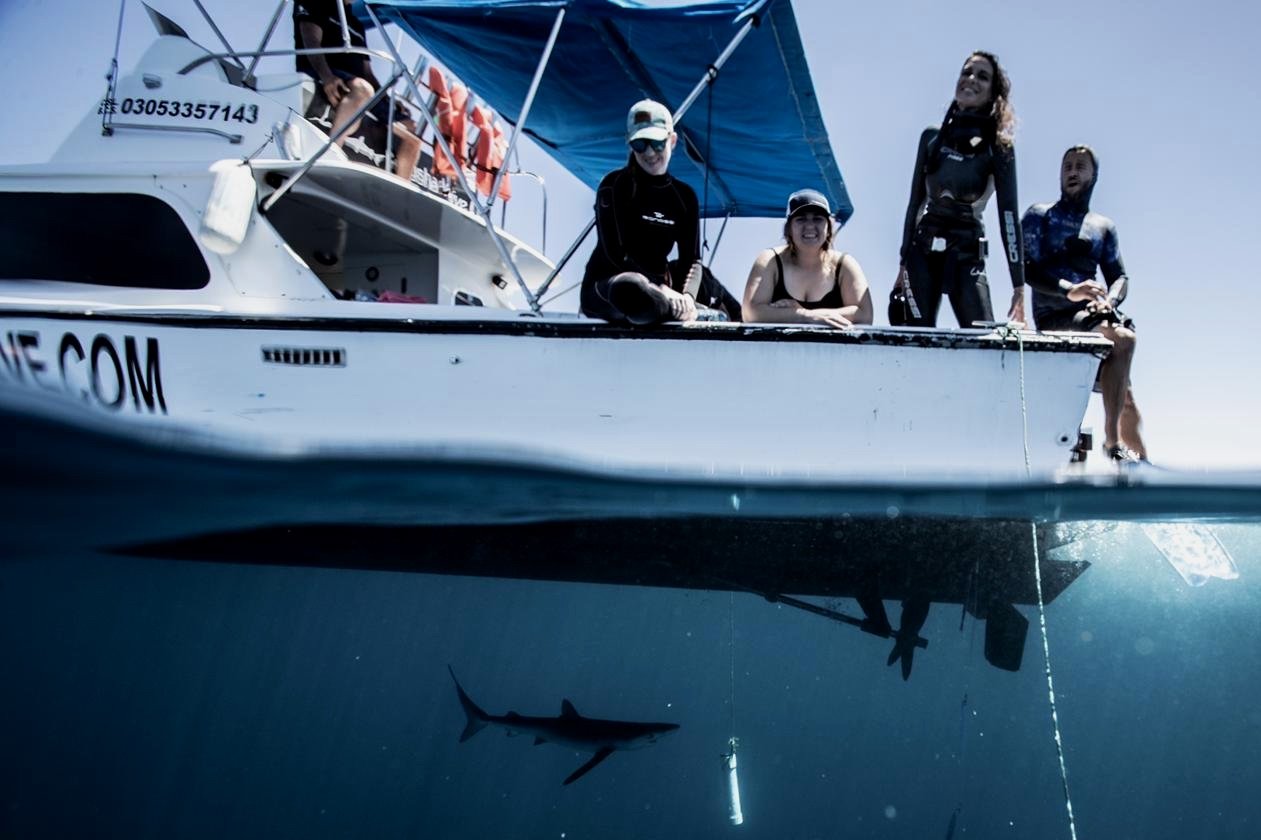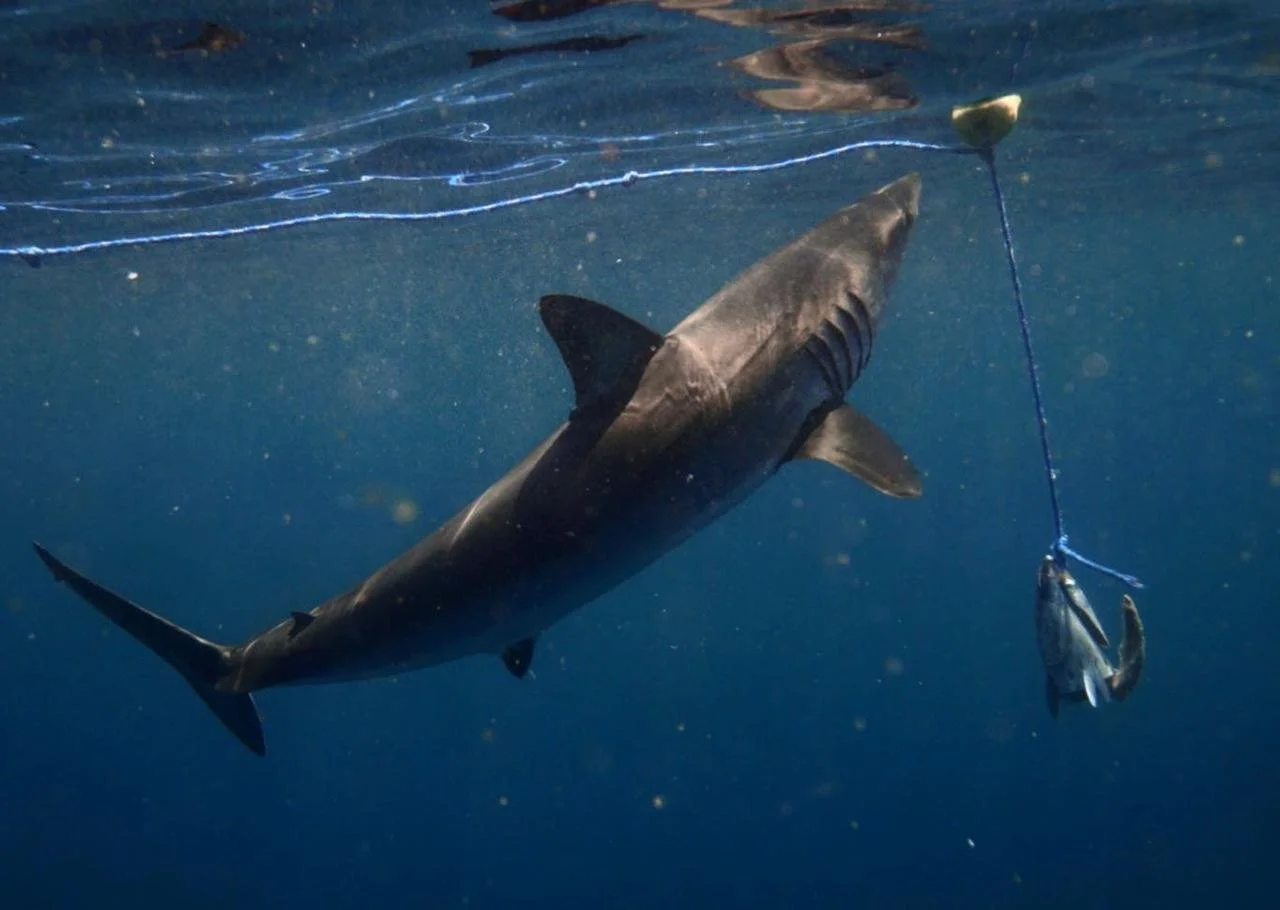
PELAGIC SHARK MONITORING PROGRAMME
SHARK TOURISM & CITIZEN SCIENCE
Shark tourism is set to grow rapidly worldwide. Over the past few years, shark tour operations have been flourishing, particularly in destinations like Los Cabos. The increase in interest and demand for experiences involving sharks is driving this significant growth in the industry. Therefore, the use of tourism platforms and citizen science has begun to be chosen as an effective method for studying pelagic sharks.
Pelagic sharks like the short fin mako or the blue shark, are elusive and higly migratory species. Due to their complex life cycle, their study is complicated in logistical and monetary terms. The main goal of the project is to estimate population dynamics of pelagic sharks through tourism and citizen science. Partnering up with several shark tour operators, we have established a data collection protocol for pelagic sharks. Shark guides and crew are trainned to collect shark population registers using standardized protocols on an ongoing basis.
Project background:
The project started in 2016 with the goal of establishing an inventory of pelagic shark species in Cabo San Lucas, as there was no scientific data published on the region. Additionally, our objective included identifying seasonal variations in their population abundance and presenting data that advocates for incorporating shark tourism operations and citizen science into the study of pelagic shark species. To achieve this, shark guides underwent training to record environmental variables and the abundance of species during each shark tour. Following several years of data collection, we developed the first citizen science protocol for continuous monitoring of pelagic shark species in Cabo San Lucas.
Project specific goals:
Continue to monitor pelagic shark population dynamics in the area on a long-term.
Expand the monitoring citizen science data collection protocol to recently established shark tour operators.
Estimate the value of living sharks as a resource for marine tourism locally.
Estimate the carrying capacity at shark sighting sites.
Rise awareness of the need for shark conservation to the general public.
Involve the local community in our conservation efforts.
Set up conservation and management strategies for sustainable shark-attraction activities.
Project Results
In 2023, we published the results of four years of monitoring data—the first official scientific information regarding the occurrence of pelagic sharks in the Cabo San Lucas area.
SHARK TOURISM & EDUCATION
Citizen scientists are vital to the success of our shark conservation project. We use citizen science for shark conservation and shark tourism as a data source for research. An important part of the project is to bridge the gap between the general public and shark conservation efforts by offering a range of activities, from educational seminars to hands-on shark diving experiences. Also changing the public perception people have on sharks as menacing eaters into a more accurate understanding of their role in the marine ecosystem and the importance of their conservation.
The aims of the study were to investigate the environmental drivers that influence pelagic shark presence, to determine their seasonality and to establish a long-term monitoring program using a shark tourism operator. In the first three years of monitoring, we observed eight shark species, with I. oxyrinchus, S. zygaena, and C. falciformis being most abundant. Our results determined SST, wind speed and year to be significant predictors of presence for all three species. Photoperiod and moon illumination were significant predictors for S. zygaena presence and sampling site was a significant predictor for both I. oxyrinchus and C. falciformis.
Pelagic shark surveys were made in the vicinity of Cabo San Lucas Bay and five main sampling sites were visited ranging from 2 to 10 miles from the coastline and with depths between 450 and 700 m.
Pelagic shark surveys were conducted 2016-2018 from a tour operator boat.
Shark attractions methods
Provisioning tehcniques like chumming, baiting, and a chum box were use to to attract sharks for observation.
Chumming: is the practice of attracting sharks by throwing "chum" into the water. This soup is poured from the boat continuously to create the olfactory path that the shark will follow from the open water to our spot.
Baiting: visual presentation of a piece of fish , tied to a rope. Here the shark may or may not bite the bait, but it is notfeedingas such. It is useful to keepthe shark interested nearbythe boat.
Citizen Science
Tourists were briefed on safety and shark species ID. Guides recorded number and species of sharks and environemntal factors such as sea surface tempature, wind direction, and current. Moonlight, day length, and chlorophyll levels were noted upon return.
Project key findings
This is a summary of the key findings from our scientific publication, which presents four years of monitoring data on the occurrence of pelagic sharks in the Cabo San Lucas area.
INTRODUCTION
STUDY AREA
METHODOLOGY
RESULTS & CONCLUSSIONS
Strong seasonality was observed for these species. The shortfin mako shark, I. oxyrinchus, being the dominant species during the cold season (December to March), the smooth hammerhead, S. zygaena, during the transitional season (April to June) and the silky shark, C. falciformis, during the warm season (July to November).
High wind speeds increased the probability, as the chum scent was dispersed further increasing the chances of a shark detecting it and swimming towards the boat.
Mako sharks were most commonly observed over deep canyons and silky sharks were most likely observed over seamounts.
Using a shark tourism operator is a useful platform for scientists: data is collected at no additional costs and the general public is informed.
Project Activities:
Each shark tour offers the public an opportunity to snorkel and interact closely with some of the most misunderstood and endangered shark species, such as the shortfin mako, blue shark, silky shark, and smooth hammerhead shark. These tour operations allow us to gather vital information about the nearby shark populations.
PELAGIC SHARK VISUAL CENSUS: the crew registers the number of sharks, shark species, sex and size, behavioral data, and special markings on each individual shark during every shark tour. Videos and photos are also recorded and introduced to our data bank.
OCEANOGRAPHIC VARIABLES: total abundance, shark species and site location are recorded along with environmental factors like wind direction, wind speed and sea surface temperature (SST) in situ. Moon illumination, photoperiod (day length) and chlorophyll concentration are also recorded on return to land.
PHOTOGRAMMETRY: using underwater lasers and an underwater camera, we can estimate the size of the encountered sharks. These measurements help us evaluate the size structure of their population.
SOCIO-ECONOMIC VALUATION: anonymous questionnaires are provided to all participants to estimate the economic revenue generated by the shark tourism industry in Los Cabos.








